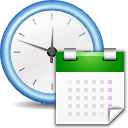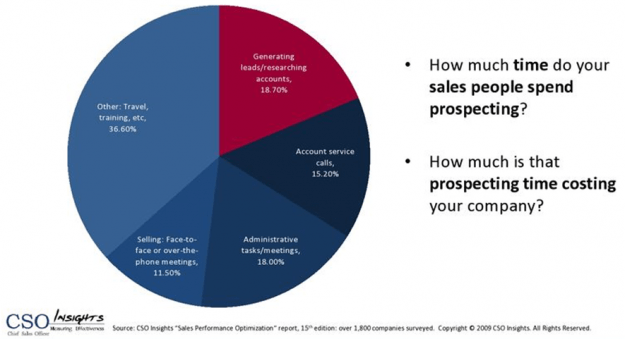Increase Sales Productivity
 Would you be surprised if you knew your sales people were only selling 11.5% of the time? CSO Insights, who surveyed over 1,800 companies, found this to be true. As a best practice, business should increase sales productivity by focusing sales on selling instead of spending their time traveling, training, researching, prospecting, servicing customers, and handling administrative tasks. This article quantifies the impact of an unproductive sales force and provides suggestions on how you can increase sales productivity.
Would you be surprised if you knew your sales people were only selling 11.5% of the time? CSO Insights, who surveyed over 1,800 companies, found this to be true. As a best practice, business should increase sales productivity by focusing sales on selling instead of spending their time traveling, training, researching, prospecting, servicing customers, and handling administrative tasks. This article quantifies the impact of an unproductive sales force and provides suggestions on how you can increase sales productivity.
Quantifying the impact of inefficient sales
Let’s say you were a vendor with twelve sales people. Let’s assume the average, fully burdened (benefits, vacation, training, salary, bonuses, stock, etc.), cost of a sales person is $100,000. The total cost of your sales force would be $1.2M. If 11.5% of their time is spent selling, that’s only $138,000 of the sales budget spent on selling and $1,062,000 spent not selling. You’ll never get to 100%; however, what if sales could focus more on selling and less on doing other things to increase sales productivity by a minimum of 8.5%? With 2,080 working hours in a year, 8.5% of that is 177 hours. With a sales force of twelve people that’s another 2,124 hours (177 hours x 12 people) that could be spent selling. That’s a full year! Would you be interested in bringing on a new sales person, at no charge, who will sell 100% of his/her time? You can by improving productivity of your existing sales force.
How you can increase sales productivity by 8.5% or more
Revenue generation software as well as other handy tips will help you increase sales productivity. Here are our suggestions:
1. Prospect more efficiently. It’s usually not a best practice for sales, especially outside sales, to invest time in prospecting. However, it’s an essential part of any lead generation strategy. Use a solution that provides a database of millions of professional contacts and companies to find targeted prospects in a single-click and spare the expense of digging through contacts not knowing who to call. If possible, refrain from buying lists and identify your target individuals. Who are your influencers, technical buyers, economic buyers, and users and what are their roles?
2. Pre-package presentations optimized around the context of a sales meeting. Sales people spend a lot of time customizing presentations to fit their meetings. Build presentations for specific industries, solutions, or audience levels (engineering, executive, etc.). Lowering preparation-oriented tasks will increase sales productivity.
3. Stream real-time web visit alerts to sales. Lead tracking technology exists to identify and surface, in real time, known and unknown leads. We posted a previous article on tracking website visitors that explains this concept further. Not only is this a new source of leads, it tells sales who is interested and when. If a prospect opens an email and clicks a link to your website sales can be notified in real time. This intelligence tells sales a prospect is online and engaged. If a sales person’s outbound call capacity is 30 calls per day and an email campaign to 1,000 prospects shows when 30 of those prospects are interested and thinking about your solution at that very moment, it makes sales highly efficient and they’ll chalk up a productive day. The ancillary benefit is a happy sales person. With less voicemails, calls, and brush offs sales will feel like they’re making an impact.
4. Have sales focus on qualified leads only. Sales analysts report 80% of marketers send unqualified leads on to sales. How can this increase sales productivity? Use lead qualification technology, also known as lead scoring, to automatically send qualified leads to sales. By splitting up a sales pipeline to form a revenue cycle shared by marketing and sales you’ll increase sales productivity. First, start by creating a service level agreement between sales and marketing. Define the ideal customer profile, what makes a qualified lead, and establish a lead scoring program. Make sure to include activity levels (online behavior) and recency of interaction/response of your leads as part of your scoring program.
5. Consider hiring a lead qualification specialist, sometimes referred to by companies as a demand generation team. A lead qualification specialist is an intermediate resource, or liaison, between marketing qualified leads and sales. The concept is that the lead qualification specialist intercepts a marketing qualified lead to further qualify it as a sales qualified lead before handing the lead to sales. On average, about 10% of “sales-ready” leads are sales qualified leads and 16% of those will eventually buy. Try to optimize sales’ time on the sales qualified leads to increase sales productivity. Technology will only go so far to help qualify a lead (the marketing qualified lead). Human intervention allows further qualification that technology typically does not provide such as budget, authorization, need, and time line.
6. Formulate a closed-loop lead nurturing system. Lead nurturing is the process of developing a positive long-term relationship with leads/prospects through meaningful dialogue, and then tracking their development into sales opportunities. Have marketing and sales collaborate to create a lead nurturing program, document it in your service level agreement, and build it using a drag and drop graphical user interface, available in some marketing automation packages. Effectively, you’ll build a formal lead flow system for leads to travel from marketing to sales and back to marketing if necessary. Make sure to use lead nurturing technology that allows sales to pass leads that are not quite ready to buy back to marketing to avoid “lead leakage”. This is a fantastic way to recycle your leads and increase sales productivity.
7. Use offers that setup appointments for sales. When sending out email marketing messages as part of a lead nurturing campaign, make sure to include offers that keep sales busy with sales-centric meetings. For example, offer free consultations, a personal demonstration, or personalized ROI analysis. Having your email marketing program act as an admin will decrease sales administrative tasks and increase sales productivity.
8. Get more out of your purchased lists. At Lead Liaison, we don’t recommend buying lists since the people on the list most likely have no idea who you are. A better practice is to build up your own database of interested prospects or folks you’ve had relationships with (at some level) and nurture your database, thereby leveraging your existing assets. The result is a lower cost per lead as marketers don’t have to pay for new leads. However, if you must buy a list then consider your approach to marketing to that list very carefully. Don’t just send a single email message asking for an appointment or the sale. Focus on building a longstanding relationship with your contact. Start by sending them educational material and increase product-related content as the contact expresses interest in your solutions through their interaction with your website. Over time, you’ll be able to surface who’s interested and who is not and increase sales productivity.
9. Have marketing send personalized emails on behalf of sales. Always, always, always (is that enough) personalize your emails by sending them from the sales person or a marketing contact. Never send a generic email blasted to your entire database. It may work, but you’ll get a much higher hit rate if you personalize your messages. Try incorporating the recipient’s name and company in the message to increase click-through rates. Limiting the number of emails sales has to customize and send manually will increase sales productivity.
10. Reactivate your old leads. As mentioned above, a great strategy is to re-market to your database. First, start by creating a breakdown of the age of the contacts in your database for a period of 3 months each. For example, 0-3 months, 3-6 months, and so on to get a snapshot of the age of your database contacts. As a suggestion, re-market to leads 1 year or older then 9-12 months old, etc. You’ll help reduce the 18.7% of time your sales people spend on lead generation and allocate more of their time to sell.
Contact Lead Liaison to learn how we can help your business with lead scoring, lead nurturing, sales prospecting, lead generation, activating old leads, personalize email on behalf of sales, get more from purchased lists, and track leads in real time with our revenue generation software. After all, we want you to “sell more, do less” with an increase in sales productivity.
We welcome your feedback, comments and suggestions. What have you done to increase sales productivity?
To be alerted of future posts, please click on the RSS button.





